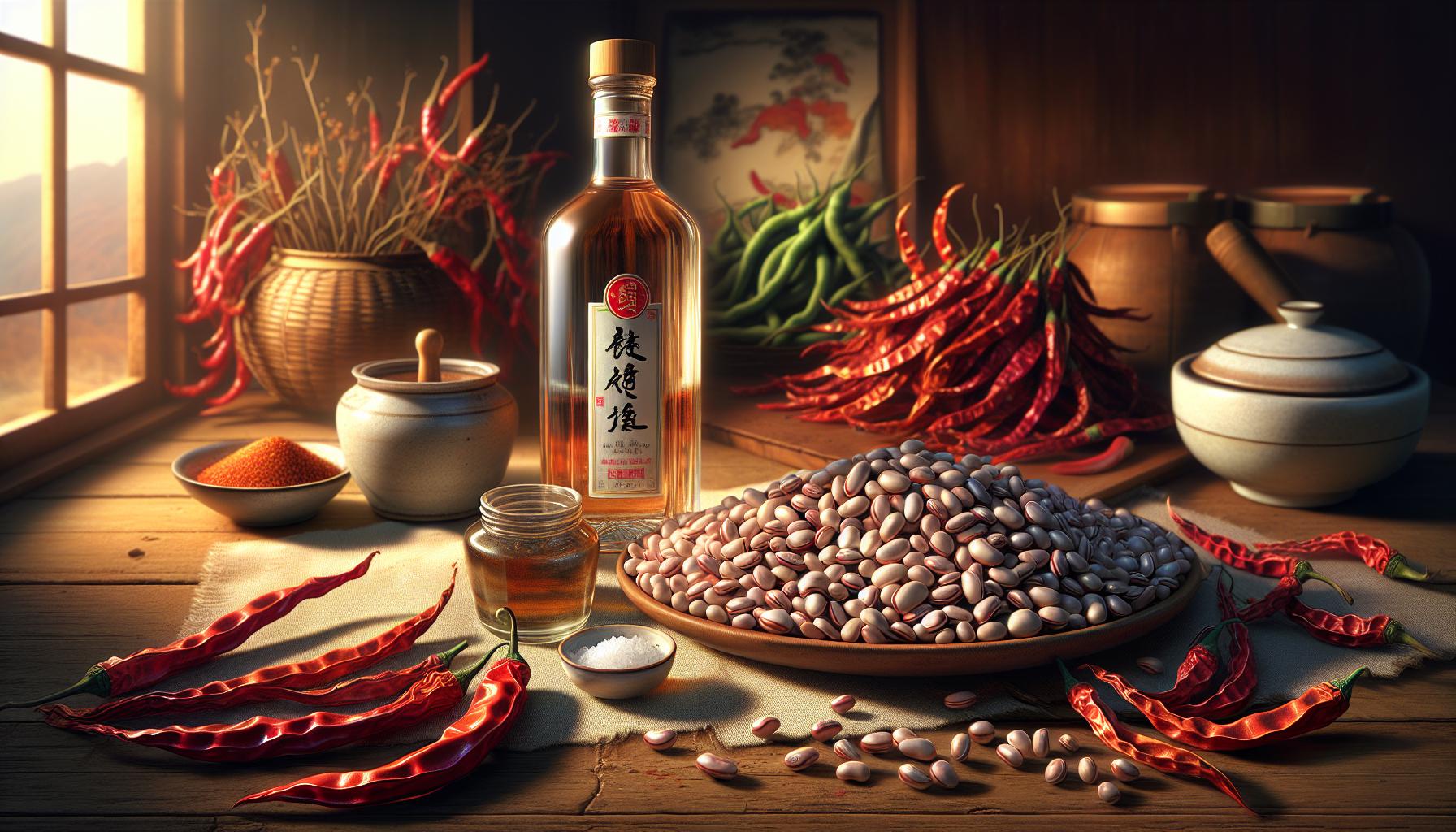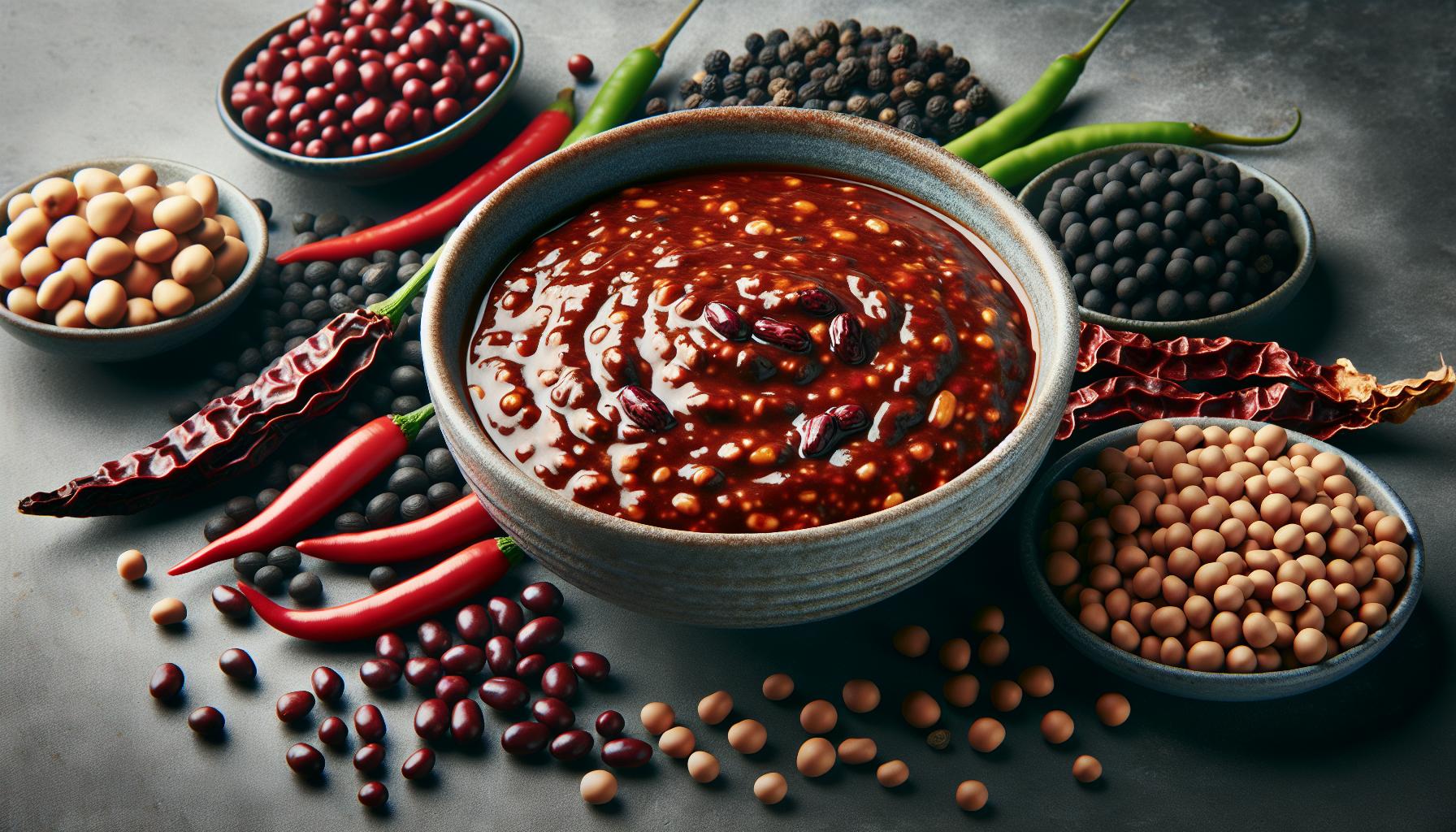Choosing the Right Ingredients
Doubanjiang, or spicy fermented bean paste, is more than just a sauce. It’s the essence of Sichuan cuisine. To guarantee success at home, you’ll have to have the right ingredients at hand. Let’s break these down.
Key ingredients are simple but crucial: broad beans and red chili peppers. Check out local Asian markets, where you’re likely to find them fresh. Better yet, if you’ve a knack for gardening, try your hand at growing your own. Ensuring the quality of your ingredients takes you a big step towards a flavorful Doubanjiang.
For broad beans, you’ll need about 500 grams. Choose the ones with bright color and no dark spots. They must be fully matured, displaying a somewhat square shape. As for red chili peppers, aim for 1000 grams. The peppers should be fresh, fully ripened, and, of course, spicy.
Salt and distilled liquor complete the list. You’ll need 400 grams of salt and 50 ml of Chinese Baijiu. Use uniodized salt for a pure, authentic flavor. And, if you can’t locate Baijiu, a clear distilled spirit like vodka makes a fine substitute.
Don’t worry about additional flavoring. It’s the fermentation process that gives Doubanjiang its unique, rich, and spicy punch. Follow this guide and your homemade paste will blow any store-bought sauce out of the water!
Suggestions for alterations and experimentation are always welcome. For instance, incorporating some black beans can make your Doubanjiang darker and more complex. However, these basic ingredients remain non-negotiable for any batch of Doubanjiang.
To give an idea about the nutritional content of these ingredients, consult the table below:
| Ingredient | Calories | Carbs | Protein | Fat |
|---|---|---|---|---|
| Broad beans (500 g) | 620 kCal | 110 g | 43 g | 2 g |
| Red chili peppers (1000 g) | 405 kCal | 89 g | 19 g | 4 g |
| Salt (400 g) | 0 kCal | 100 g | 0 g | 0 g |
| Chinese Baijiu (50 ml) | 115 kCal | 0 g | 0 g |
Preparation Process

Let’s dive into the preparation process. It’s a pretty straightforward ordeal, but, just like any recipe stuffed with authenticity and tradition, it requires patience and precision.
First, soak 4 cups of broad beans in water overnight. The next morning, drain them thoroughly. They’ll form the base of your sauce and add volume.
Here comes the fun part – procuring and preparing red chili peppers. Aim for about 2 cups. Remember, the hotter the chili, the spicier your Dobuanjiang will be. Don’t forget to deseed them, cut them into small pieces, and sun-dry for about 2 days.
Now, let’s nourish the beans with some liquid love. For that, use 1 cup of Chinese Baijiu. The alcohol helps in the fermentation process. Place the soaked beans and chopped chili peppers in a jar, pour the Baijiu over it, and try to play the waiting game. Your ingredients need at least three weeks to ferment.
In the meantime, let’s add some seasoning to your mix. Stir in 3/4 cup of salt into the jar. This won’t just improve the taste but also act as a preservative, keeping your Dobuanjiang fresh and flavorful for a long time.
A tip for the adventurous folks out there is to experiment. Perhaps you’d like to toss some black beans into the mix? It gives your Doubanjiang a darker color and a more complex flavor. Let your culinary creativity take the lead here.
Let’s not forget about the nutritional breakdown for those health-conscious chefs out there.
| Ingredient | Calories | Carbs | Protein | Fat |
|---|---|---|---|---|
| Broad Beans | 341 | 62g | 24g | 3g |
| Red Chili Peppers | 40 | 2g | 2g | 1g |
| Chinese Baijiu (shot) | 90 | 0g | 0g | 0g |
| Salt | 0 | 0g | 0g | 0g |
| Black Beans | 200 | 36g | 12g | 2g |
Remember, different brands and types of ingredients can cause variations in nutritional content, so always check your labels.
Fermentation Techniques

Doubling down on fermentation, you’ve got to note it’s nothing short of an essential step. How you handle this process can either make or break your homemade Doubanjiang.
To kick off, you’ll need airtight containers to store your ingredients during fermentation. These include your soaked broad beans and prepared red chili peppers. Remember, every container must be thoroughly cleaned, ensuring any potential bacteria or microorganisms are eliminated. Such could interrupt the fermentation process.
Once your broad beans and chili peppers are in these clean containers, here comes your Chinese Baijiu. It’s used in this case not for drinking but to supercharge the fermentation process. Pour it gradually, making sure every part of your ingredients is well soaked.
You might be wondering – why Chinese Baijiu? Well, this traditional Chinese alcohol is known for its high alcohol content. High alcohol volume accelerates the rate of fermentation and offers an authentic taste.
From here, you’re onto the salting process. Salt isn’t just a taste enhancer; it’s also a natural preservative. While proportioning, understand it’s not about creating a salty taste, but about ensuring the longevity of your Doubanjiang.
It’s time to let nature do its thing – ferment. Seal your containers and place them in a cool, dark spot to ferment for a minimum of three weeks. Fermentation is a waiting game, but patience pays off in providing a unique, complex flavor.
Bear in mind that during the fermentation process, popping open the container to peek might be tempting, but it’s not ideal. Exposure to light and atmosphere could interfere with the fermentation process. Your commitment needs to be holding on to get that unique Doubanjiang taste.
Last but not least, remember: Doubanjiang recipes can be flexible. Explore other types like the black soybean for a more complex flavor. Personalize it to suit your taste buds. After all, making homemade Doubanjiang is essentially a trial-and-error journey of flavor discovery.
Storing Your Homemade Doubanjiang

Now that your Doubanjiang is ready, you’ll want to be sure it’s stored properly to maximize flavor and longevity.
First and foremost, always store your Doubanjiang in an airtight container. A glass jar works best as it doesn’t absorb flavors and is easy to clean. If properly sealed and stored, homemade Doubanjiang can last for up to 2 years in the fridge.
If you notice any mold or odd smells, it’s best to discard it. Monitor your Doubanjiang closely in the first few weeks of storage. It’s important to keep in mind Doubanjiang’s unique, strong aroma – just because it smells unfamiliar doesn’t mean it’s spoiled.
Temperature plays a crucial role in the storage of Doubanjiang. It should be kept in a cool, dark place, like your fridge. A temperature of around 5°C (41°F) is ideal.
Let’s look at the Doubanjiang storage data for quick reference:
| Preferred Storage | Duration | Temperature |
|---|---|---|
| Sealed Glass Jar | Up to 2 years | 5°C (41°F) |
Remember, homemade Doubanjiang will always be better when used fresh. Like the proverbial wine, it does get better with age, giving you a fabulous, complex flavor to enhance your culinary creations.
Cooking Tips and Recipe Ideas

Let’s dive into some game-changing cooking tips and fun recipe ideas for your homemade Doubanjiang.
First off, you’re not limited to using broad beans. Spice things up by co-adding black soybeans for a richer, darker Doubanjiang. Remember, a 1:1 ratio is a good starting point when experimenting with different beans.
To give your sauce an extra kick, incorporating Xiang La Jiao (a type of Sichuan pepper) will set your creation apart. Just a teaspoon is enough to do the trick – remember, it’s all about balance!
For some dish ideas to make the most of your homemade sauce. It’s the perfect addition to Mapo Tofu, a comforting Sichuan classic. The distinctive, bold flavor profile of Doubanjiang does wonders for this dish. Your friends and family will surely notice the difference!
For a simple appetizer, add Doubanjiang to your stir-fried eggplant. This combo is simply sublime, offering a sweet and spicy contrast that tantalizes the taste buds.
For those keen on nutrition facts, here’s a snapshot. However, keep in mind these can vary based on the specific ingredients and proportions you use:
| Nutrient | Per 100g |
|---|---|
| Calories | 130 |
| Carbs | 24g |
| Protein | 12g |
| Fat | 2g |
Don’t be afraid to get creative. Your homemade Doubanjiang opens an exciting world of sumptuous flavor exploration. Remember, it’s all about trial and error – you’ll find what makes your culinary heart sing with every new venture.
Conclusion
So, you’re now equipped with the know-how to whip up your own homemade Doubanjiang. With black soybeans and Xiang La Jiao, you’re all set to add that rich, spicy kick to your dishes. Don’t forget to experiment with it in your Mapo Tofu or stir-fried eggplant. It’s not just about the unique taste, but also the nutritional value that this sauce brings to your meals. Remember, the beauty of homemade Doubanjiang lies in its versatility. So, go ahead and explore those flavor combinations, let your culinary creativity run wild. You’re now part of a centuries-old tradition of making Doubanjiang at home. Enjoy the journey!

